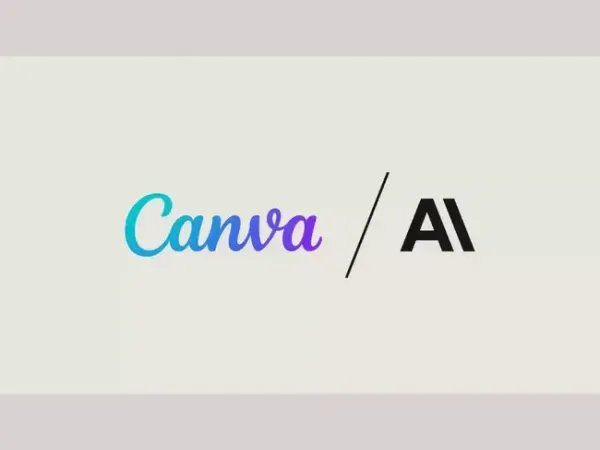In a broader expansion of its automation capabilities, Anthropic’s Claude AI chatbot on Tuesday enabled integration with Australian design software startup Canva. The integration allows Canva’s users to create and edit designs through conversational commands. This marks the first time an AI assistant is letting users to design with Canva directly, inside a chat, the company said.
Users can generate visual content, resize images, and autofill brand templates without leaving the Claude chat interface, marking the company’s move beyond text-based tools to now offer visual design workflows.
The Canva connection operates through Anthropic's Model Context Protocol (MCP), which acts as a standardised bridge between AI assistants and external applications.
MCP is an open-source standard developed by Anthropic that allows AI models to securely access and work with third-party tools. It simplifies connectivity and functionality sharing between apps.
To access the feature through Anthropic's new Connectors Directory, users are required to buy a paid subscription for both Claude and Canva. With subscription, users can create presentations, resize images, and even fill out templates by giving text prompts.
Claude can use Canva tools to search for materials within a user’s workspace, including brand templates using keywords or links. It can also autofill brand templates with required content based on user prompts.
Claude is also being used at companies such as Notion, Stripe, Prisma, Socket, and Figma, making it useful across a wider range of applications.
Canva thrives in the AI era
The Australian platform said it has a headcount of over 5,000 employees. Canva has expanded its technological capabilities from mid-2024. Samantha Garrett, who heads the internal AI Solutions team within the IT Department, explained, "We knew it was up to us to give our team the space and time to test, learn and discover what good prompting looks like.”
"We knew there would be rapid developments in different tools that would benefit different groups. We wanted to provide room for experimentation," Garrett added.
In March last year, Canva acquired the Affinity suite of creative software popular with Mac users, securing its biggest acquisition to date, in an effort to compete with Adobe Inc.
On thoughts around AI strategy and regulation, Canva cofounder and chief executive Melanie Perkins, in an interview with ET last year, said, “We want to ensure that our community has access to AI in their learning, jobs so they can understand how to be more effective."
"A lot of governments around the world are trying to figure out their AI strategy. There are a lot of interactions that are happening with these agencies as they devise their policies and we are engaging with these policies across the world," she added.
The India chapter
In a move to increase investment in India, ET reported in February that India is the fourth largest market for Canva, behind the US, Brazil and Indonesia, and is likely to become the biggest in the next three to five years.
Canva is also pushing for growth in its user base from India as well as revenue, as it brings out more localised offerings while increasing its focus on enterprise customers.
To bring the vision alive, Canva is set to launch its website in Hindi, to make all of its offerings available in the language to Indian consumers.
Over the last year, the company has also doubled its team size in India, adding roles across engineering, marketing, sales and content.
Users can generate visual content, resize images, and autofill brand templates without leaving the Claude chat interface, marking the company’s move beyond text-based tools to now offer visual design workflows.
The Canva connection operates through Anthropic's Model Context Protocol (MCP), which acts as a standardised bridge between AI assistants and external applications.
MCP is an open-source standard developed by Anthropic that allows AI models to securely access and work with third-party tools. It simplifies connectivity and functionality sharing between apps.
To access the feature through Anthropic's new Connectors Directory, users are required to buy a paid subscription for both Claude and Canva. With subscription, users can create presentations, resize images, and even fill out templates by giving text prompts.
Claude can use Canva tools to search for materials within a user’s workspace, including brand templates using keywords or links. It can also autofill brand templates with required content based on user prompts.
Claude is also being used at companies such as Notion, Stripe, Prisma, Socket, and Figma, making it useful across a wider range of applications.
Canva thrives in the AI era
The Australian platform said it has a headcount of over 5,000 employees. Canva has expanded its technological capabilities from mid-2024. Samantha Garrett, who heads the internal AI Solutions team within the IT Department, explained, "We knew it was up to us to give our team the space and time to test, learn and discover what good prompting looks like.”
"We knew there would be rapid developments in different tools that would benefit different groups. We wanted to provide room for experimentation," Garrett added.
In March last year, Canva acquired the Affinity suite of creative software popular with Mac users, securing its biggest acquisition to date, in an effort to compete with Adobe Inc.
On thoughts around AI strategy and regulation, Canva cofounder and chief executive Melanie Perkins, in an interview with ET last year, said, “We want to ensure that our community has access to AI in their learning, jobs so they can understand how to be more effective."
"A lot of governments around the world are trying to figure out their AI strategy. There are a lot of interactions that are happening with these agencies as they devise their policies and we are engaging with these policies across the world," she added.
The India chapter
In a move to increase investment in India, ET reported in February that India is the fourth largest market for Canva, behind the US, Brazil and Indonesia, and is likely to become the biggest in the next three to five years.
Canva is also pushing for growth in its user base from India as well as revenue, as it brings out more localised offerings while increasing its focus on enterprise customers.
To bring the vision alive, Canva is set to launch its website in Hindi, to make all of its offerings available in the language to Indian consumers.
Over the last year, the company has also doubled its team size in India, adding roles across engineering, marketing, sales and content.








